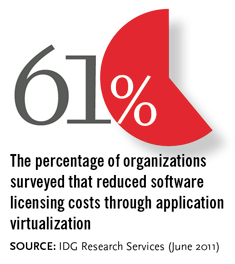Why School Districts Virtualize Applications
It's not unusual for tech-savvy high school students to express interest in graphics-intensive applications — subjects such as 3D architecture, modeling and computer-aided design tools — that take up a lot of real estate on any type of computing platform.
The Hartford Union High School District IT department had to confront this desire for high-end computing power head-on when district leaders decided to equip the entire freshman class with 10-inch Companion Touch mini-tablets from M&A Technology and the Intel Learning Series for the 2011–2012 school year.
"We knew that the devices we were issuing couldn't easily run high-end apps, so we considered both desktop and application virtualization," says Chad Behnke, director of technology services for the single-school district in Hartford, Wis. "Application virtualization turned out to be a lot less expensive and accomplished our goal of making high-end programs accessible to kids throughout the building, either on their own devices or in labs and libraries."
Behnke's team installed Citrix online plug-ins on each student tablet in October 2011, thereby enabling the devices to access virtual applications through Citrix XenApp, which runs on the server side. The district currently has about 100 concurrent licenses of XenApp installed, but Behnke says he will buy more as more applications are virtualized. So far, he hasn't had to purchase more licenses for virtualized applications such as Adobe Creative Suite or those from Autodesk, but that may change eventually, he says.
This year's incoming freshmen, Behnke adds, received 11.6-inch Lenovo X130e ThinkPads, which offer faster speed and a more comfortable keyboard.
Local or Express?
As Hartford Union High School District and other districts around the country have discovered, application virtualization is appealing for a variety of reasons. Benefits include greater uptime, easier manageability, faster deployments and provisioning, and lower infrastructure and software licensing costs.
"It's almost a no-brainer — so much so that we have found that more than 55 percent of enterprise applications now run on virtualized servers," says Dick Csaplar, a senior research analyst at Aberdeen Group.
According to Ron Reyer, director of technology services for the Bethel Park (Pa.) School District, virtualization is best suited for applications somewhat outside the norm — those that are difficult or time-consuming to install, that are used by a small subset of students or teachers, or that have limited software licenses. "An app for music students, or one that helps teachers create tests, is a great candidate for virtualization," he says.
It's certainly better than sending a team of technicians all over the district to install apps locally on every computer or dedicating time to writing complicated scripts to install them remotely, he adds.
BPSD started virtualizing these types of apps about three years ago using Microsoft Application Virtualization (App-V). Today, the district has nearly 20 virtualized apps, and Reyer says the IT department always assesses whether newly adopted applications are appropriate to virtualize.

But not all applications are deemed worthy. "When we get a new one, we always evaluate it to see if it's a good candidate for virtualization," Reyer explains. "Sometimes, due to the complexity of the app, it simply isn't. For example, if the install routine would make the process of packaging that app more challenging than it would be worth, we won't virtualize it. And for thick installations like Microsoft Office, we prefer to install apps locally on each device."
Like Reyer, Matt Jones isn't new to application virtualization. He is the local leader of Winton Woods City Schools' VMware users group and has been experimenting with the technology for about two years.
As the Cincinnati district's network supervisor, Jones is in the thick of an ongoing rollout of virtual clients using VMware View. The implementation includes 150 VDI seats and 150 licenses for VMware ThinApp, VMware's application virtualization solution.
Jones has taken full advantage by virtualizing Microsoft Office and a few specialty apps (including one for special-needs students). "It's very useful for applications with a limited set of users and for those for which we get a lot of support calls," he explains. "With application virtualization, I can make a difficult-to-use app into a single, graceful file. And the risk of damage is less. If you make a bad app install with a regular installation, you can blow away a Windows system folder. But that doesn't happen with application virtualization."
So far, the district has virtualized about 20 apps, mostly in conjunction with its VDI implementation. "I'd like to virtualize many more applications," Jones says, noting that he has 30 of them ready to go when the time comes. "I'm just waiting to get the budget to do it."
Application Virtualization and the Cloud
The idea of accessing software applications from the cloud — also known as software as a service (SaaS) — is hardly new. Closely related, and growing slowly but steadily, is the concept of application virtualization in the cloud.
"Instead of worrying about where Microsoft Office is running and supporting those resources, think about a model where the apps are running in the cloud, and the user is just calling down the interface," explains Dick Csaplar, a senior research analyst at Aberdeen Group. "It's all hosted by a cloud provider, so you don't have to worry about server capacity, troubleshooting or availability."
The cloud-based model for application virtualization also simplifies software licensing because the apps are now being rented instead of purchased. The cloud provider manages licensing fees, charging the school district on a per-user, per-month basis for only what is used. This not only simplifies licensing but also reduces costs because school is in session for only nine months of the year. (For many districts, software licensing costs nearly zero out during the summer months.)
Although it's a nascent model, application virtualization in the cloud is taking off fairly quickly. In May, for example, VMware introduced Horizon Application Manager, an on-premises virtual appliance for the cloud that brokers user access to applications, as well as virtual clients and data resources. The appliance provides access to virtualized Windows applications, enterprise web apps and SaaS apps from a single catalog.
What's more, Horizon Application Manager helps IT staff deliver access to application services with granular levels of context, including end-user identity, location and device. This improved insight into access and usage enables IT to better manage end users and control costs, while allowing end users to seamlessly connect to applications on their device of choice, whenever they need to do so. The solution also supports nondisruptive patches and updates, and comes with management and administrative consoles.








